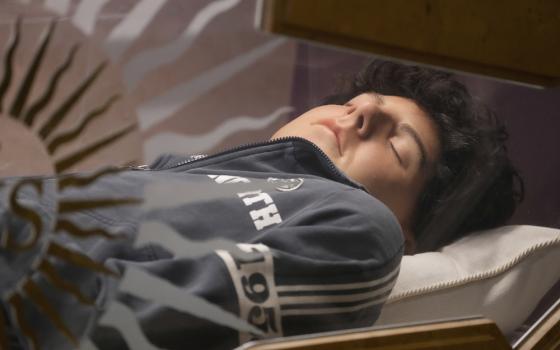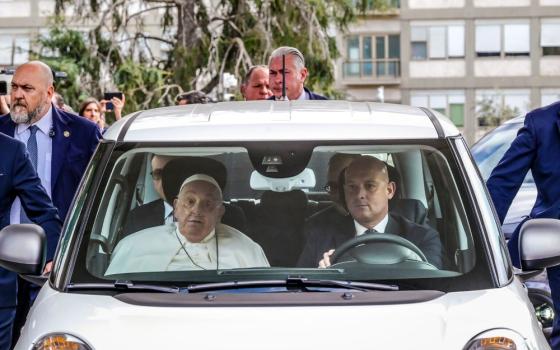
A sign about tuberculosis is pictured taped to a light pole across the street from the Centers for Disease Control and Prevention headquarters April 1 in Atlanta. (AP photo/Ben Gray)
There is perhaps no American writer who depicts the lived experience of illness better than John Green. His 2012 novel The Fault in Our Stars has sold more than 23 million copies, not simply because of its tear-jerking depiction of star-crossed lovers, but because he writes teenagers with cancer as multifaceted people.
His 2017 bestselling novel Turtles All the Way Down, which features a 16-year old protagonist living with obsessive-compulsive disorder, does something similar for mental health. Green does not shy away from showing the reader how illness affects all aspects of an individual’s life, but he also never reduces the complexity of the person down to their diagnosis. People are not defined by their illness.
Green, who is a Christian, tells NCR that his faith informs and supports his call to advocate for the full humanity of those living with sickness: "My faith tradition very clearly tells me that where we see the marginalized, the oppressed, the poor, and the imprisoned, we also see God. My faith calls me to work in community toward a world without marginalization and oppression."

His advocacy, particularly for global health equity, takes many forms, but it is possible that his most impactful work is his new book, Everything is Tuberculosis: The History and Persistence of Our Deadliest Infection, which has already spent two weeks atop the New York Times bestseller list. In it, Green introduces us to Henry Reider, a young man from Sierra Leone living with drug-resistant TB. As in his YA novels, Green once again manages to show us how illness has shaped every aspect of a young person’s life: After developing a drug-resistant strain of the disease, Reider must live in a residential treatment center, separated from his parents and losing all ties with his old friends and school. But we are given a Reider who is more than his disease. We learn about his poetry and his YouTube videos, and though he is clearly lonely and scared, he also comes across as funny and kind.
And unlike Green’s other protagonists, Henry Reider is real.
Most of us in the West probably know people with cancer and/or mental illness. We are far less likely to know someone suffering from TB, and this is Green's purpose with this book. According to the World Health Organization, "Worldwide, TB has probably returned to being the world's leading cause of death from a single infectious agent." TB killed about 1.25 million people in 2023, despite effective treatments. Green knows that numbers like these, though horrifying, remain abstract.
We need to see how the disease affects individuals and communities in order to care enough to work for change. As he writes late in the book, "When we know about suffering, when we are proximal to it, we are capable of extraordinary generosity. We can do and be so much for each other — but only when we see one another in our full humanity, not as statistics or problems, but as people who deserve to be alive in the world."

A patient shows a positive reaction to the Mantoux skin test. The test is given via syringe, injecting the testing fluid tuberculin between skin layers. The injection site becomes hard and red in someone with tuberculosis. In Everything is Tuberculosis, John Green educates readers on how TB affects individuals and their communities. (Unsplash/Centers for Disease Control and Prevention)
Everything is Tuberculosis is effective, in part, because Green manages to do exactly this — he helps the reader become aware of how this disease affects specific individuals and their communities, and he introduces us to people who are working to provide care where it is needed. He also writes about his own treatment for OCD and depression, and how the health care he receives contrasts, sharply, with what is available in less affluent parts of the world. The book is, among other things, a crash course in global health policy and equity; he explains how social determinants of health, like "food insecurity, systemic marginalization based on race or other identities, unequal access to education, inadequate supplies of clean water," should not be thought of as separate from the health care system, "because they are essential facets of healthcare."
All of this might make the book sound like homework, but it is a fascinating page-turner. Green has had multiple bestsellers because he is an engaging writer; he knows how to tell a story and hold our attention. Over nearly 200 pages, he really does manage to connect just about everything back to TB — and in entertaining, informative ways. He writes about how TB touches on such disparate areas as fashion (including approaches to facial hair, hemlines, and the invention of the cowboy hat), geography (the creation of TB sanatoriums led to the founding of cities like Pasadena and Colorado Springs, and TB was instrumental in New Mexico achieving statehood), history (Green relates a wild story about how the assassins of Archduke Franz Ferdinand were dying from TB, and so unconcerned about the personal consequences of their crime) and the arts (there was a seemingly inexhaustible supply of consumptive poets).
We also learn about the scientists, researchers and health care providers who worked together (and, at times, in competition) to find a treatment and ultimately a cure for TB. In our own current moment of "vaccine skepticism" and the systematic gutting of the National Institutes of Health, the Centers for Disease Control and Prevention, and other government funding for scientific and healthcare research, it is good to have a book like this, written for a popular audience, that demonstrates how transformative scientific breakthroughs — like vaccines and other scientifically validated medical treatments — can be for both individuals and communities.
Advertisement
Green, who is currently on a media blitz for the book, is very aware that this progress is in danger. "I would give anything for my book to be less timely," he has reiterated. Unfortunately, as the Trump administration dismantles USAID and withdraws from the WHO, the globe is becoming less stable and less healthy. When ongoing medical treatments are disrupted, diseases like TB develop drug resistance and then these new strains spread, both in the poorer countries where they are already prevalent, and in richer countries that should be using their resources to prevent exactly this scenario. As Green writes, "TB doesn't just flow through the meandering river of injustice; TB broadens and deepens that river."
For many years, Green has used his personal wealth, from book sales and movie rights, alongside his social media megaphone (in addition to being a bestselling writer, Green is a YouTube star; he and his brother Hank host the shows "Vlogbrothers" and "Crash Course," among many other social media ventures) to work for global health equity. This book is one logical outgrowth of this work.
Everything is Tuberculosis persuasively makes the case that true global health equity would require that we "reform our systems to include the impoverished as well as the rich, offering what Catholic liberation theologians called 'a preferential option for the poor.' "
Though it feels like we are moving further away from this kind of reform at the moment, Green's work serves as an important reminder for Catholics, and all people of goodwill, what true justice looks like.






